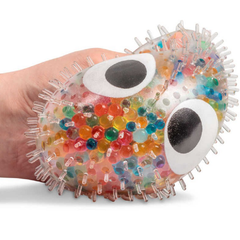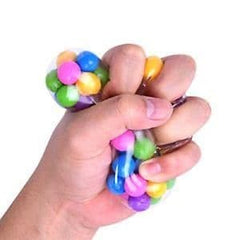Stress balls have become an useful tool for stress relief and hand exercise and popular as fidget toys and stress toys. These squeezable, pliable balls have gained immense popularity for their ability to provide comfort in moments of stress and anxiety. Whether you’re looking for stress relief toys for adults, fidget stress balls for kids, or hand therapy balls for rehabilitation, there’s a perfect stress ball out there for every need. Want to explore a curated range of high-quality stress balls? Check out our full collection here.
There is a huge variety of choice from dna stress balls, giant stress balls to mesh stress balls! But have you ever wondered what's inside a stress ball? What is the mystery inside these colourful, squishy balls. From the materials used to the science behind their stress-relief properties, we will delve deep into the heart of fidget stress balls.
Stress ball - The Outer Shell.
Before we explore what's hidden inside a stress ball, let's start with the outer layer—the part we interact with most. Stress balls are typically made of a soft, rubbery material that offers a comfortable grip. This outer shell plays a big role in how the stress ball feels when squeezed and contributes to its popularity as a top anxiety toy and focus tool for fidgeters of all ages.
Materials Used in Stress Ball Shells:
- Polyurethane (PU) Foam: PU foam is a common material used for the outer shell of stress balls. It is known for its softness, durability, and ease of customization. PU foam can be moulded into various shapes and textures, making it perfect for stress ball production.
- Thermoplastic Rubber (TPR): TPR is another material used for stress ball exteriors. It provides a soft, tactile feel and is resistant to wear and tear.
- Silicone: Some stress balls are made from silicone, which is known for its flexibility and hypoallergenic properties. Silicone stress balls often have a smoother, less textured surface.
These materials are key to what makes fidget stress balls a go-to choice for sensory seekers, those managing anxiety, or anyone looking for compact and effective stress relief toys.
Stress Ball - The Filling
Now, let's get to the heart of the matter—what's inside the shell of a stress ball. The filling of a stress ball is where the magic happens, as it's responsible for the ball's squishy, malleable nature and its stress-relief properties.
- Gel-Filled Stress Balls: Gel-filled stress balls are among the most popular variants. These stress balls are filled with a gel-like substance, often a mixture of water and glycerine or a similar non-toxic, viscous liquid. The gel inside the ball provides a satisfying resistance when squeezed, making it an excellent tool for stress relief. Gel stress balls are also highly rated among stress toys for school, desk toys for the office, and autism-friendly fidget toys thanks to their sensory benefits and ease of use. They're often called sugar stress balls or Maltose stress balls.
While both the maltose stress ball and sugar stress ball are designed for squeezing, fidgeting, and relieving stress, the key difference lies in the type of gel inside and the sensation when squeezed.
Maltose Stress Ball:
- Filling: Dense, slow-moving maltose gel
- Feel: Provides a heavy, slow-rebound squeeze with more resistance and a “weighted” feeling in your hand.
- Sensory Benefit: Great for people who enjoy deep pressure input and a firmer tactile sensation.
- Best For: Sensory seekers, or those looking for a calming, grounding effect.
Sugar Stress Ball:
- Filling: Smooth, free-flowing sugar gel
- Feel: Offers a light, soft, and fast-squish texture that moves quickly under your fingers.
- Sensory Benefit: Perfect for people who prefer a quick-release, soft tactile experience.
- Best For: Those who like lighter, more playful textures for stress relief and fidgeting.
Summary:
- Maltose = slow, heavy, deep squeeze
- Sugar = soft, fast, light squeeze
Both are fantastic tools for anxiety relief, focus, and sensory regulation, but which one you choose depends on your preferred squeeze style!
-
Foam-Filled Stress Balls:
Some stress balls are filled with foam beads or particles. The foam filling gives the ball a different texture and feel compared to gel-filled ones. When you squeeze a foam-filled stress ball, the foam compresses, offering a unique tactile experience. These types are commonly found in bulk stress balls, often used as giveaways or affordable options in larger stress ball sets. You can also try a Globe Stress Ball for a fun, educational foam stress ball experience shaped like the Earth.
-
Sand-Filled Stress Balls:
As the name suggests, these stress balls contain sand. The sand provides a slightly gritty texture and weight to the ball, making it ideal for hand exercises and stress relief.
-
Memory Foam Stress Balls:
These stress balls contain memory foam, the same material often found in pillows and mattresses. Memory foam is known for its ability to conform to the shape of your hand when squeezed, providing a comfortable and supportive grip.
-
Air-Filled Stress Balls:
Some stress balls are simply filled with air. These stress balls are soft and squishy, but they don't offer the same resistance as gel or foam-filled ones. They are typically lighter and easier to manipulate.
The Science of Stress Relief!
Now that we know what's inside a stress ball let's delve into the science behind how they work to relieve stress and anxiety.
- Muscle Relaxation: When you squeeze a stress ball, the muscles in your hand and forearm contract. As you release the squeeze, these muscles relax. This repetitive action promotes muscle relaxation and can help reduce tension. For many users, stress balls double as hand therapy tools, aiding in recovery from injuries and improving grip strength through daily use.
- Stress Reduction: The act of squeezing and releasing a stress ball can also have a psychological impact. It can divert your attention away from stressors, providing a momentary break from worry and anxiety.
- Sensory Stimulation: The various textures and materials used in stress balls can provide sensory stimulation. Some people find the tactile experience of squeezing a stress ball soothing and calming.
- Hand Exercise: Regular use of a stress ball can also improve hand strength and dexterity. This makes stress balls a valuable tool for individuals recovering from hand injuries or conditions like carpal tunnel syndrome.
In the world of stress relief tools, stress balls fidget toys have secured their place as accessible and effective aids. Now that we've peeled back the layers to understand what's inside a stress ball, from the outer shell to the various fillings, we can appreciate the science behind their stress-relief properties. Whether you prefer a gel-filled, foam-filled, or sand-filled stress ball, these little companions offer a simple yet powerful way to manage stress, improve hand strength, and find comfort in the palm of your hand. So, the next time you reach for your stress ball, you can do so with a deeper understanding of its inner workings.
If you're searching for the best stress balls in the UK, or trying to find a stress toy gift set, check out our stress ball range that combines function, fun, and fidgeting!
How to Use a Stress Ball: A Fun and Relaxing Guide for Kids and Adults
Life can be busy and stressful, but a simple tool like a stress ball can help both kids and adults feel calm and focused. Whether you have a stress ball set with different types or just one special stress ball, knowing how to use it can make a big difference! Many people also use stress balls as part of their daily wellness routine, combining physical movement with mindfulness to help regulate emotions and boost mood.
Why Use a Stress Ball?
Using a stress ball regularly can be really helpful because it:
- Reduces stress and anxiety – Squeezing a stress ball helps you relax and feel better.
- Improves focus and concentration – Great for school, work, or even while watching TV.
- Strengthens hands and wrists – Helps with hand exercises and can even improve fine motor skills.
- Feels fun to play with – Different textures in a stress ball set make them enjoyable to use.
How to Use a Stress Ball
- Squeeze and Release
- Hold the stress ball in one hand and squeeze as hard as you like.
- Hold for 3-5 seconds, then let go.
- Repeat 10-15 times to feel relaxed.
- Roll It in Your Hands
- Move the stress ball around with your fingers and palm.
- This is great for making your hands stronger and feeling calm.
- Pass It Between Hands
- Move the stress ball from one hand to the other.
- Helps improve coordination and focus.
- Try Different Balls
- Use a stress ball set with different firmness levels.
- Start with a soft one and work up to a firmer one to make your hands stronger.
When to Use a Stress Ball
- During Homework or Work – Helps you stay focused and stress-free.
- In Classrooms – Teachers often recommend stress balls for kids with ADHD or sensory processing needs as calming classroom fidget tools.
- Before Bedtime – A relaxing way to wind down.
- While Traveling – Keeps your hands busy and mind calm.
- After Playing Sports or Drawing – Helps stretch and relax your hands.

Choosing the Right Stress Ball
There are different types of stress balls, so pick one that feels right for you! Some are soft and squishy, while others are firm. Some even light up or have cool textures. You’ll also find glow-in-the-dark stress balls, stretchy stress toys, and scented fidget balls, all tailored to suit different preferences and sensory needs. A stress ball set is a great way to try different kinds and find your favourite.
Final Thoughts
Using a stress ball is a simple and fun way to feel better, whether you’re a kid or an adult. Keep one in your bag, at your desk, or by your bed so you can use it anytime you need to relax. Looking for a full stress ball set or something to suit stress relief on the go? We've got options for travel, work, school, and home.
If you're looking for the best stress balls or a stress ball set, check out our collection at Playinc.co.uk and find the perfect one for you.
Featured Stress Ball Set
Looking for a ready-made collection of the most satisfying, best-selling stress balls?
👉 Shop our Stress Ball Set at Playinc.co.uk! 👈
Our exclusive set includes customer favourites like DNA stress balls, mesh balls, and spiky balls — all carefully chosen to provide the ultimate stress relief and fidgeting fun. Perfect for adults, kids, office desks, classrooms, or anyone who loves a good squish!
Our Best-Selling Stress Balls at Playinc
Looking for the perfect stress-relief companion? At Playinc, we offer a range of best-selling stress balls designed for ultimate squishability and sensory satisfaction.
From the Squishy Bento Box Stress Toy, featuring adorable sushi-style fidgets, to our DNA balls, mesh stress balls, and glow-in-the-dark fidget balls, there's something for everyone. Whether you need a calming fidget for focus, anxiety relief, or just some satisfying squishing fun, explore our collection and find your perfect stress toy today!
These are more than just toys – they’re top-rated fidget stress balls for adults and kids alike. Whether you're managing anxiety, focusing at your desk, or just need to squeeze your stress away, these sensory balls deliver.
Take a look at our handy Stress Ball Checklist for the advantages and disadvantages of each type of stress ball.









